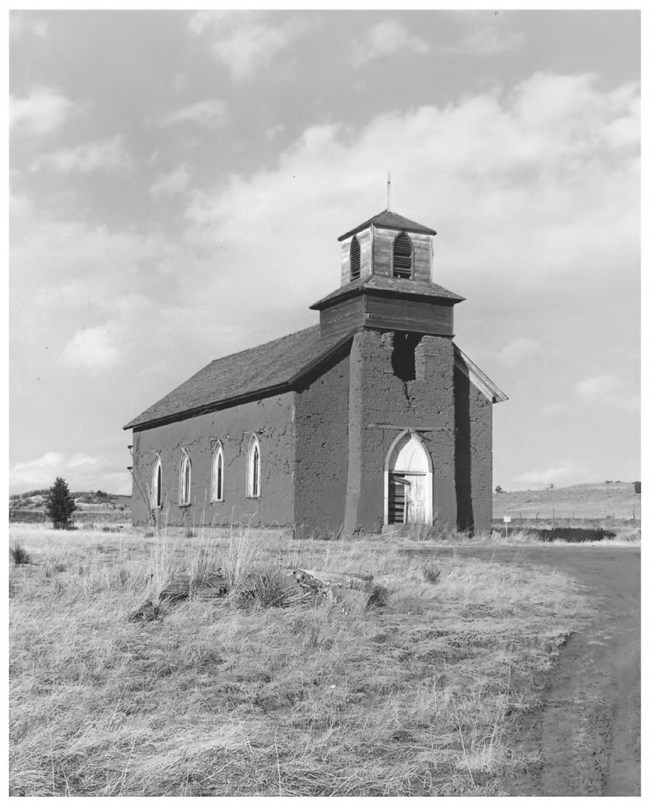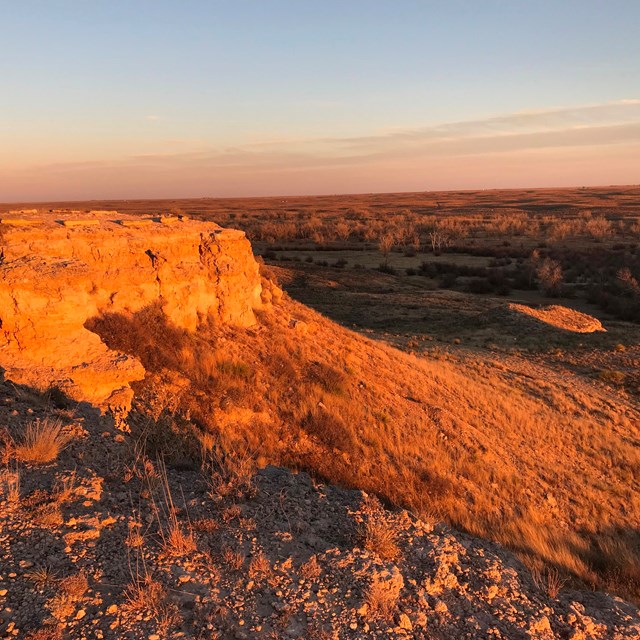Part of a series of articles titled University of New Mexico Student Essays: Santa Fe National Historic Trail.
Article
University of New Mexico Student Essay: La Cueva Historic District

Photo/NPS
La Cueva Historic District
By Sean O'Neill
In the latter half of the nineteenth century, the small Hispanic village of La Cueva played an important role in commerce along the Santa Fe Trail. Yet La Cueva was used for more than just trade—people lived, worked, and worshiped there. The site consists of several structures: the two-story Romero Hacienda, a grist mill, a mercantile building, the church of San Rafael, stables, a farm, some acequías (irrigation ditches), and a few outbuildings.
Founding La Cueva
Located in the middle of the Mora Land Grant, La Cueva was founded by Vicente Romero around 1851. Although he was not one of the original grantees, Romero managed to purchase shares totaling 33,000 acres from original grantees or their descendants. The name ‘La Cueva’ (‘the cave’) has many possible origins. Romero had been a sheepherder, and legend has it that he utilized caves in the area to seek shelter when needed—thus earning him the nickname ‘La Cueva.’ Others say the ranch’s name simply came from a nearby cave. While the name’s origin may never be known, one thing is certain: Romero realized the potential of the land, the power of the nearby Mora River, and the need for grain on the Santa Fe Trail.
Milling, Farming, and the Santa Fe Trail
La Cueva’s location in the lush Mora Valley helped turn the area into an important stop along the Santa Fe Trail. Romero would divert a portion of the Mora River into a network of acequías that powered an on-site grist mill (the La Cueva Mill). These ditches also provided irrigation to Romero’s farm—a system used throughout the former Spanish empire in what is now the American Southwest. Regional mills were crucial for travelers in the nineteenth century, providing processed grain that diversified the simple fare endured by most overland travelers. La Cueva’s grist mill provided milled flour and wheat to Fort Union in nearby Watrous. The Southwest’s largest fort in the late nineteenth century, Fort Union was integral to the Union Army during the Civil War. As many as sixty horses and oxen delivered milled grain to the fort each day.
A Place to Meet, Trade, & Rest
The Romero hacienda served as a community center for the region. While few records exist, we do know that ranchers and travelers throughout the region would stop at the house to meet. The hacienda was attached to a mercantile store and a large stable where travelers could buy supplies and water their horses. A network of mercantile stores like Romero’s helped the Santa Fe Trail become an important artery for the United States’ occupation of New Mexico in the 1840s; the trail also became a military supply route during the Civil War, with stores along the trail offering provisions for marching armies. The exact goods that Romero sold are unknown, but items commonly traded in Santa Fe offer a hint: dry goods, hardware, clothing, guns, books, liquor, groceries, and more.
A Mission Arrives
Romero also commissioned a place of worship on his property, which would become known as the San Rafael Church. Construction began in 1862 and finished in 1870. Priests from nearby Lamy came to help build the church, which became a family chapel for the Romeros and for subsequent property owners, as well. The church was last used in the 1950s, although recent restoration efforts have revitalized the building.
La Cueva Today
The La Cueva Historic District is located at the intersection of NM 442 and NM 518, 33 miles northwest of Fort Union National Monument. Today, La Cueva contains a private residence as well as a farm. In the summer months travelers can pick raspberries and bring them home. Despite these modern touches, the area still retains the historic character of the Mora Valley and its early Hispanic inhabitants.
Historic Images
---
Baker, T. Lindsay. Water for the Southwest; Historical Survey and Guide to Historic Sites. New York, N.Y.: American Society of Civil Engineers, 1973.
Koman, Rita G. "The Hispano Ranchos of Northern New Mexico: Continuity and Change." Teaching with Historic Places series. Washington, D.C.: National Park Service, 2002.
Purdy, James H. "La Cueva Historic District.” National Register of Historic Places Inventory/Nomination Form. Santa Fe, N. Mex: State Records Center and Archives, 1972.
The Urbana Group. "Santa Fe Trail." National Register of Historic Places Multiple Property Documentation Form. Urbana, Ill.: The Urbana Group, 1993.
Note: This collaborative research project was formulated to give students of all levels in the University of New Mexico’s Department of History valuable academic and professional experience while also providing trail partners (and the general public) with useful essays on historic trail sites. This particular essay comes from a student in Dr. Fred Gibbs’ class on the national historic trails in fall 2018. Learn more on the collaboration that made this course possible.
Last updated: January 26, 2021


